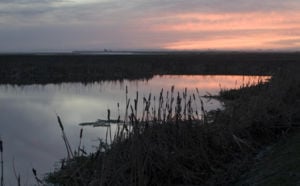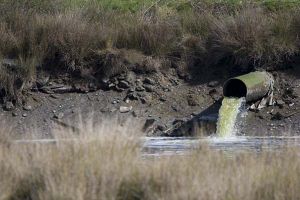Definition
Wastewater treatment effluent or discharge is the final product from a wastewater treatment plant. Because of the Federal Clean Water Act, the requirements for the treatment of the water is set on a plant-by-plant basis determined by the National Pollutant Discharge Elimination System (NPDES).

Effluent uses
Effluent can have a variety of uses, although most effluent is dumped into rivers and large bodies of water or used for irrigation and industrial use. Effluent is also used to enhance wetlands and marshes which can attract more wildlife to the region and possibly create a recreational area. Spraying or injecting the discharge into the ground above a non potable aquifer and letting it seep down is a common way of routing the water for industrial use, but using the effluent directly from the plant for drinking water has been done in the United States on a very limited basis.
Toilet-to-tap
Toilet-to-tap or direct potable water has been shunned by the public eye in the United States but as more studies are being done it is gaining popularity. One concern with injecting treated wastewater into potable aquifers is that there are unregulated chemicals from pharmaceutical drugs, and hormones that get past the wastewater treatment. Not only have these been an issue when they are disposed into a body of water but these chemicals would be getting into the drinking water in higher concentrations. There are technologies available that can remove these chemicals but they have so far proven too costly and inefficient for widespread use. Currently Orange County in California is involved in a study that is treating and injecting wastewater into a nearby potable aquifer to replenish drinking water supplies. This could possibly be a practical solution for southern California because as much as 85 percent of potable water is imported from northern California and one fifth of the states' energy goes towards transporting this water.
Regulations
The limitations placed on the effluent of wastewater treatment plants by the Federal Clean Water Act are based on a Best Available Technology system which is run by the National Pollutant Discharge Elimination System (NPDES). Every plant must fill out an application for a permit from the NPDES. These permits make the applicant consider both the impact on the quality of the water that's receiving the effluent, as well as the best practical technology available to them. If the effluent will be dumped into a watershed area then the applicant may also have to include the results of a Total Maximum Daily Load (TMDL) test with their application. If the effluent of the applicant is not clean enough to meet the water quality standards from TMDL of their region the NPDES will reject the application and require them to put in place more stringent expectation and invest in better technology. The Environmental Protection Agency (EPA) determines the specific limitations through WET testing.

WET Testing
WET testing or Whole effluent toxicity measures the response of an organism when exposed to the effluent in question looking specifically at effects on lethality, growth, and reproductive capabilities. The WET tests for acute toxicity include a control and at least 5 different effluent concentrations. The results are measured in the percent of dose that is lethal to half of the population of the organism.
Water Quality Trading
The NPDES is currently working on a effluent toxins trading program somewhat like the one in place for sulfur dioxide. This is because in some areas certain pollutants are more expensive to remove. Treatment plants who are in the more expensive areas will be able to buy credits of the pollutant from a plant that has surplus credits that's in a cheaper area. A plant gains credits by reducing their output of the pollutant to below what they are required to. This way it is cheaper for some plants to operate, as well as promoting the reduction the amount of pollutants in effluent. Although because some effluents are disposed of in more fragile areas, not every plant will be able to purchase credits. Namely plants in watersheds or preservation environments.
Links/References
- Federal Clean Water Act -See subchapter 3 for regulations on effluent